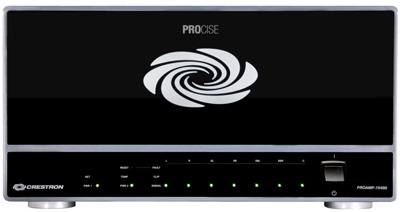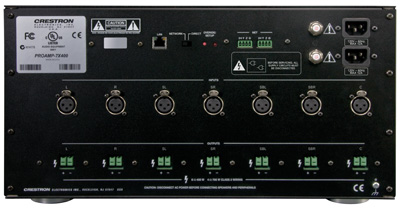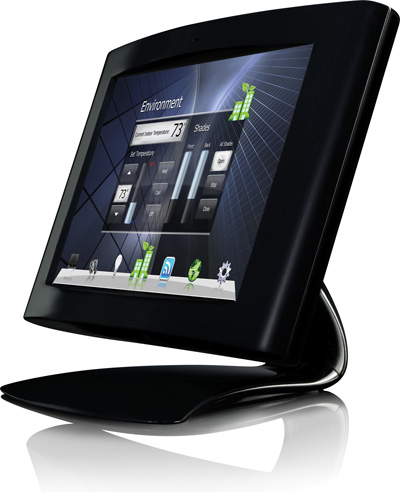|
Crestron Offers "Procise" Audio Solutions By Jim Bray Its name may not be known in most households, but Crestron is hoping that will change, at least as far as well-heeled households are concerned. The company is best known for whole house solutions, automating corporate boardrooms and the like. After having spent a couple of months living with and listening to their high end PROCISE audio system, however, I can say safely that this foray into home theater audio is a fine one indeed. Whether it's worth the price of a small car is something that only you can decide. I know if I had the money left over to contemplate such a purchase, I'd definitely give PROCISE a listen. Let's get that price out of the way first, just so we know in what part of the atmosphere we're living here. For my listening tests, Crestron set up its PSPHD surround sound processor ($11,000), ProAmp7x400 ($8,000), CP2e Compact Control System with Ethernet ($1,800), TPMC-9 Isys 9 inch Tilt Touchpanel ($3,800) and CEN-POE5 Power over Ethernet Switch ($400). I used the stuff with my existing speakers, audio/video sources and Epson front projection LCD monitor. Creston's equipment added up to the tidy sum of $25,000, according to the calculator Bill Gates tossed in with his operating system, so we're either talking about serious equipment or a company with delusions of grandeur. Fortunately, it's the former: this stuff sounds great and if it's installed and set up properly would be a very, very cool system for many years. Custom installers, who will be more familiar with Crestron than most mere humans, must be licking their chops in anticipation of moving a few examples of this "Bugatti Veyron of audio systems." The PSPHD is the heart, indeed the brain, of the system. It's where you hook in all your sources and it's extremely cool, right down to a front panel that lets you display the power output via "virtual VU meters" as if it were an old fashioned amplifier. This may seem a bit weird, since it isn't an amplifier at all, but I loved it. You can also have it display the inputs in use or a "spectrum" readout that looks kind of like a digital version of the "analog" VU meters I liked so much. Crestron says the high-definition 7.3 surround processor is designed for both commercial and residential applications. It offers three independent subwoofer outputs to send oomph pretty well anywhere, to ensure powerful bass is distributed to every seat (or to other rooms). It also acts as your audio/video control unit, with its integrated HDMI switcher (six in, one out), and "Intelligent Pairing" that helps it talk to the seven channel PROAMP amplifiers – of which there are two. My sample was the bigger of the two, and output a delicious 400 watts per channel. The PROAMP-7X250, as its name implies, cranks out a still healthy 250 watts. I run 500 watts per channel normally, thanks to a trio of Rotel Class D amplifiers I own, so the 400 watts per channel amp gave me a nice "nearly apples-to-apples" comparison. Even though we set up the PROCISE system in a temporary installation that didn't let me exploit all its features and benefits, it looked and sounded fantastic in my home theater. It'll probably bring "oohs" and "aahs" mounted proudly in a technology stack in the corporate boardroom, too, assuming you don't have it stuck away where you can't see it. This is classy equipment, indeed. The preamp/processor has a built-in three channel line mixer and distribution amplifier to handle multi-channel HD audio as well as video teleconferencing. I did no teleconferencing, being more interested in its home theater performance with the new audio formats such as dts-HD Master Audio, Dolby TrueHD, DVD-Audio, SACD and the like – the stuff, including the lossless formats, you get from Blu-ray Disc and other high-performance media. Feeding signal to the preamp was Oppo's excellent BDP-95 Universal Audiophile video and audio player, a high end unit that offers state-of-the-art pretty well everything audio/video. We hooked it in via its 7.1 (though I only used 5.1 considering the number of speakers I have) analog outputs, which I prefer to passing audio via HDMI. The PROCISE would have been perfectly happy interacting with the Oppo either way, mind you. The only practical difference was that I was using the Oppo's onboard decoders rather than the Crestron's internal ones. After having lived with the equipment for a couple of months, however, I can't imagine that Crestron's decoding would be anything but top notch. Everything else about it works fie. I wouldn't have wanted to set the system up myself; I would probably have ended up barking at the moon. Fortunately the Crestron representative hooked his notebook PC into the system and designed the interface with which I interacted via the TPMC-9 touch screen. We only covered the basic controls, but with Crestron you can program just about anything you want into the system. The processor and the amplifier pair automatically via a simple Ethernet connection, kind of like Jake Sully and the rest of the Na'vi use their pony tails to control the fauna of Pandora – and didn't we enjoy listening to Avatar's fantastic soundtrack while auditioning the PROCISE system in concert with our 106 inch screen?
The amp hooks into the processor via big, "balanced" connectors rather than the traditional RCA cables, which can limit your choice of preamp/processor – undoubtedly to Crestron's unbridled delight. Once everything's hooked in and ready to go, you can use the PROCISE' built-in "Audyssey MultEQ XT precision automatic room compensation" system to calibrate the sound for various seating positions in the listening room. This is a very cool process that uses a microphone placed at whatever positions you want to ensure gets optimal balance, to help cut down on the "sweet spot" phenomenon. It seems to work, though it also seems like magic to me. The system also includes Audyssey Dynamic EQ, which is supposed to ensure consistent bass response, tonal balance and soundstage at any volume. Audyssey Dynamic Volume supposedly eliminates spikes in the volume level between TV programs and commercials as well as between soft and loud passages of movies. There's also a Pure mode that bypasses all signal processing to provide a direct signal path for critical listening. In practice, I jumped back and forth between Dynamic EQ and Pure mode, depending on the source I was using. My preference seemed to vary from recording to recording, though I most often used Dynamic EQ with stereo tracks from CD's or digital files and preferred Pure mode with multichannel recordings and Blu-rays. Naturally, there were some individual sources with which I preferred the reverse, which made it pretty well a case of listening a bit, deciding which I preferred, and then playing the recording through in whichever one it was. I suppose I could have kept a log as to how I liked what, but that would have required more work than I wanted to put into a temporary situation. I might do such a thing if the PROCISE were to take up permanent residence at my place, a scenario I don't see on the horizon unless the Lotto Gods were to smile and I had extra cash left over after I filled my garage with Porsches. Since Crestron had been kind enough to give me ample time to live with the system, I threw everything I had at it, short of vinyl records (though we did try a couple of digital files I had burned from some old records), from stuff I knew sounded substandard (such as older CD's that sound very thin) to things I use for reference – Blu-rays (The Incredibles, Avatar, TrondheimSolistene's audio-only Divertimenti, etc.), SACD's (including the superb 5.1 remix of Pink Floyd's Dark Side of the Moon), DVD-Audio discs (such as Dire Straits' Brothers in Arms and a Berlin Philharmonic Strauss disc). I also streamed digital music files to it via the Oppo and some server software on the PC in my home office. Crestron says the PSPHD uses three floating-point digital signal processors and 24 bit 96kHz analog/digital (and reverse) converters to achieve articulate, life-like sound with extreme dynamic range and a signal-to-noise rating of 125 dB. In practice, I could crank the system up to nearly ear splitting volumes and the system still sounded glorious, very accurate, clean and crisp, with full bodied sound and no discernable distortion that wasn't already there. It was fantastic! Not only that, but the amp never got hot no matter how much we were annoying the neighbors, indicating great thermal design by Crestron.
I was surprised that the Creston system is better suited for the cheaper, generic speaker wire you can get at the corner electronics shop than the higher end ones I run usually. The amp's speaker terminals, instead of offering the big, five way binding posts that are common across the industry, use strange little screw-type "phoenix connectors" that are undoubtedly familiar to installers but which couldn't be adapted to my thicker cables, with their banana plugs and the like. The PROCISE's outputs can feed other listening zones and you can even hook in recording equipment, which you might want in the boardroom or on karaoke night in the home theater. Balanced connectivity helps facilitate using long cables, which could be important depending upon the installation. You can control things via the processor's front panel (though why would you want to when you can have a very cool touch screen?) and you can also lock the panel out to keep the uninitiated from breaking things. Speaking of breaking things, I had some trouble getting the PSPHD processor to turn off, often having to press the virtual power button on the touch screen repeatedly. Crestron gave me computer software tools I could use to go into the system and have my way with it – assuring me I should be able to fix it that way – but I took one look and ran the other way, deciding it was better not to go poking around where I obviously didn't belong. I also got tired of the wires that had to run through my home theater, connecting the PROCISE stack with the control screen. A permanent installation could have hidden most of these, but there'd still be wire going from the screen's little control box (which we stuck under my coffee table) to the LCD module itself. If it were me buying this system, I'd go wireless, which Crestron says is doable. Most of the quibbles I had about the system were caused by it being a temporary installation in which we had to make some compromises that wouldn't have been necessary if it were to be installed permanently. The TPMC-9 LCD module also has video capability, so you can use it to monitor security cameras, preview a DVD or TV channel, or just plain spy on people. Video images can be displayed full screen or in a scalable window wherever on the screen you want it. Full-motion video is supported. I got tired of the illuminated Crestron logo on the front panel of the PROAMP 7X400. It looks kind of like a big, white fluorescent swirl or flower and you can almost read by it. Okay, it's not quite that bright, and there's nothing really wrong with having it there except for the fact that you don't need an illuminated display on an amplifier, and if you've had it installed somewhere out of sight it wouldn't be seen anyway. I can certainly understand why Crestron would want such a big, illuminated logo to display proudly, but would have preferred to see that virtual VU meter from the processor on the front of the amp. How's that for picking nits? The amp is big and weighs in at about 110 pounds, so you'll want to find appropriate space for it. It can also require two power outputs, each on separate circuits, though my 5.1 channel installation, which also went through a Rotel power conditioner, managed to get away with only one and there were no problems. Obviously, this is serious equipment meant for a serious installation in either the home or headquarters of a serious audio and videophile. As such, and with its price tag, it obviously isn't for everyone – heck, it isn't for most people! If you can justify the price, though, it's worth it, though, because its sound output really is superb. There appears to be a lot of interesting technology in this PROCISE system, too, as well as kick butt audio performance and what appears to be excellent build quality. I'd have to be a lot more well-heeled than I am now to have such a system installed in my average-sized suburban home theater, but if I were looking to upgrade to that level of equipment I'd definitely be putting the PROCISE system on my list of contenders. Copyright 2011 Jim Bray Jim Bray's columns are available through the TechnoFile Syndicate. We welcome your comments! |
|
|||||||





 It didn't hurt that the PROAMP was feeding my reference Definitive Technology speakers, the main front of which include their own built in powered subwoofers (I used them in "large" mode rather than strictly for LFE – low frequency effects), and my freestanding M&K subwoofer. They provide me with excellent sound and love to soak up gobs of power.
It didn't hurt that the PROAMP was feeding my reference Definitive Technology speakers, the main front of which include their own built in powered subwoofers (I used them in "large" mode rather than strictly for LFE – low frequency effects), and my freestanding M&K subwoofer. They provide me with excellent sound and love to soak up gobs of power. 